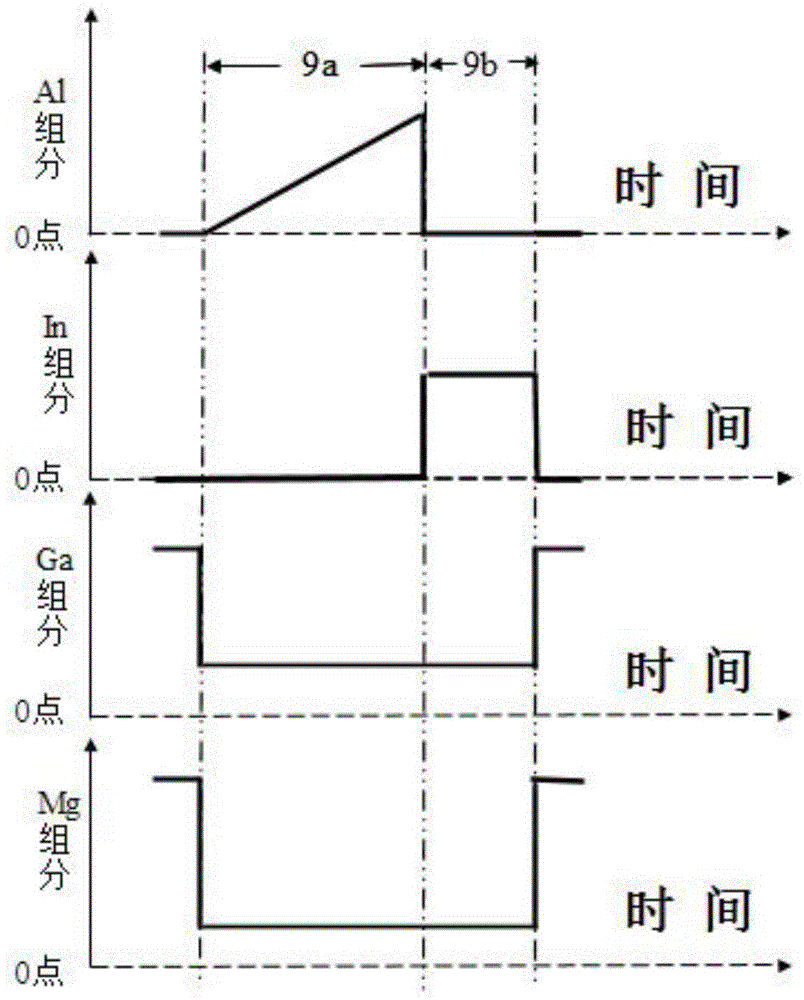A p-type insertion layer with cyclic structure and growth method
A technology of cyclic structure and growth method, which is applied in the direction of crystal growth, single crystal growth, single crystal growth, etc., can solve the problems of self-compensating deep-level hole concentration drop, crack generation, material degradation, etc., to improve crystal quality, Effect of reducing diffusion and improving injection efficiency
- Summary
- Abstract
- Description
- Claims
- Application Information
AI Technical Summary
Problems solved by technology
Method used
Image
Examples
Embodiment 1
[0026] A P-type insertion layer with a cyclic structure and its growth method, the order of its epitaxial structure from bottom to top is: substrate, low-temperature GaN buffer layer, GaN undoped layer, N-type GaN layer, multi-quantum well structure MQW, The growth method of the low-temperature P-type GaN layer, P-type AlGaN layer, high-temperature P-type GaN layer and P-type contact layer includes the following specific steps:
[0027] (1) Clean the sapphire substrate at a high temperature for 10 minutes in a hydrogen atmosphere at 1050°C, and then perform nitriding treatment;
[0028] (2) Cool down to 500°C, grow a low-temperature GaN buffer layer with a thickness of 25nm, the growth pressure is 500mbar, and the V / III ratio is 200;
[0029] (3) After the growth of the low-temperature GaN buffer layer is completed, stop feeding trimethylgallium (TMGa), raise the substrate temperature to 800°C, and perform in-situ thermal annealing on the low-temperature GaN buffer layer. The ...
Embodiment 2
[0041] A P-type insertion layer with a cyclic structure and its growth method, the order of its epitaxial structure from bottom to top is: substrate, low-temperature GaN buffer layer, GaN undoped layer, N-type GaN layer, multi-quantum well structure MQW, The growth method of the low-temperature P-type GaN layer, P-type AlGaN layer, high-temperature P-type GaN layer and P-type contact layer includes the following specific steps:
[0042] (1) Clean the sapphire substrate at a high temperature for 15 minutes in a hydrogen atmosphere at 1150°C, and then perform nitriding treatment;
[0043] (2) Cool down to 600°C, grow a low-temperature GaN buffer layer with a thickness of 40nm, the growth pressure is 800mbar, and the V / III ratio is 800;
[0044] (3) After the growth of the low-temperature GaN buffer layer is completed, stop feeding trimethylgallium (TMGa), raise the substrate temperature to 1050°C, and perform in-situ thermal annealing on the low-temperature GaN buffer layer. The...
Embodiment 3
[0056] A P-type insertion layer with a cyclic structure and its growth method, the order of its epitaxial structure from bottom to top is: substrate, low-temperature GaN buffer layer, GaN undoped layer, N-type GaN layer, multi-quantum well structure MQW, The growth method of the low-temperature P-type GaN layer, P-type AlGaN layer, high-temperature P-type GaN layer and P-type contact layer includes the following specific steps:
[0057] (1) Clean the sapphire substrate at a high temperature for 12 minutes in a hydrogen atmosphere at 1100°C, and then perform nitriding treatment;
[0058] (2) Cool down to 550°C, grow a low-temperature GaN buffer layer with a thickness of 30nm, the growth pressure is 600mbar, and the V / III ratio is 300;
[0059] (3) After the growth of the low-temperature GaN buffer layer is completed, stop feeding trimethylgallium (TMGa), raise the substrate temperature to 900°C, and perform in-situ thermal annealing on the low-temperature GaN buffer layer. The ...
PUM
 Login to View More
Login to View More Abstract
Description
Claims
Application Information
 Login to View More
Login to View More - R&D
- Intellectual Property
- Life Sciences
- Materials
- Tech Scout
- Unparalleled Data Quality
- Higher Quality Content
- 60% Fewer Hallucinations
Browse by: Latest US Patents, China's latest patents, Technical Efficacy Thesaurus, Application Domain, Technology Topic, Popular Technical Reports.
© 2025 PatSnap. All rights reserved.Legal|Privacy policy|Modern Slavery Act Transparency Statement|Sitemap|About US| Contact US: help@patsnap.com

